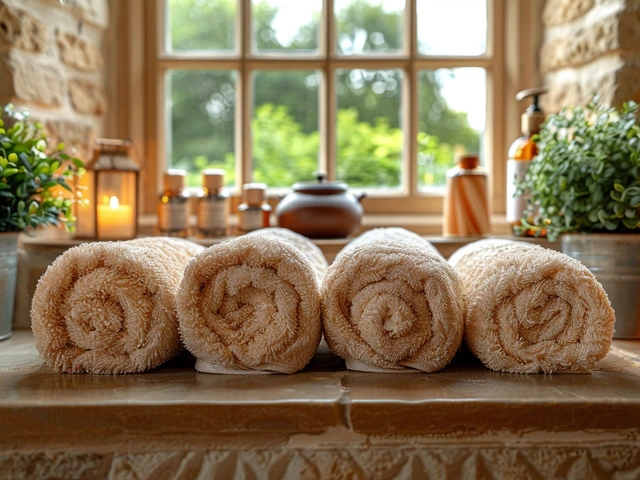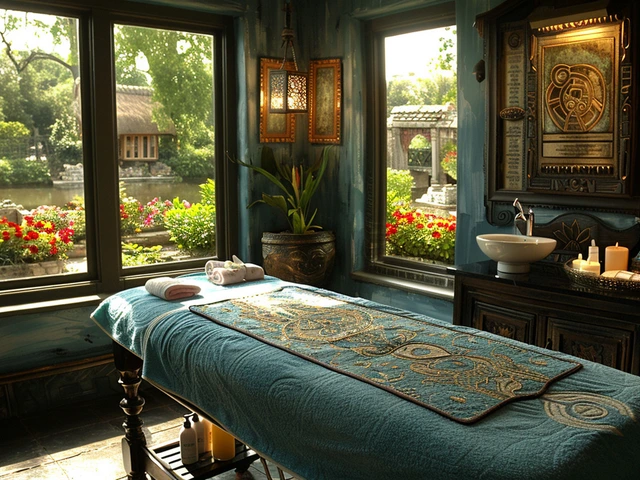If you’ve heard about Lomi Lomi massage and wondered why it’s such a big deal, you’re not alone. It’s not just hype—the science behind it gives plenty of reasons to be curious. Lomi Lomi isn’t the same as your average deep tissue or Swedish session. There’s a reason the flowing moves feel like someone is slowly ironing the stress out of your body.
The technique goes way beyond just pressing on muscles. Those long, smooth strokes have a big impact on your circulation and lymph flow, which is geek-speak for how your body gets rid of waste and brings in fresh nutrients to your cells. Right away, you might notice fewer muscle knots, lighter legs, or even deeper sleep later that night. Real studies have shown lower heart rates and even lower blood pressure after a Lomi Lomi treatment.
But don’t expect a boring, clinical vibe. The traditional Hawaiian method focuses a lot on comfort, connection, and rhythm. Picture yourself lying there, the therapist using forearms, elbows, and even body weight, so it’s like being rocked by gentle waves—except these waves are actually changing your stress hormones and helping your nervous system chill out. This isn’t magic, it’s biology—and it feels seriously good.
- How Lomi Lomi is Different from Other Massages
- The Body’s Response: Muscles, Blood Flow, and Relaxation
- The Brain Connection: Stress, Hormones, and Moods
- Real Results: What Studies and Clients Reveal
- Trying Lomi Lomi: What to Expect and Tips
How Lomi Lomi is Different from Other Massages
Lomi Lomi might look a little wild if you’re used to basic Swedish or sports massage. Right away, you’ll notice the rhythm—practitioners often use long, smooth, connected strokes that can move from your shoulders down to your toes in one go. Forget the stop-and-start kneading you might expect. Lomi Lomi flows. This isn’t just for show—this motion is meant to connect body and mind and stops you from tensing up out of habit. The goal? Full-body relaxation, not just chasing knots.
Another big difference: therapists use their forearms, elbows, and sometimes even their full body weight across your back and legs. This helps them apply steady pressure without causing pain or bruising, which is a common problem with some deep tissue work. My wife, Isabella, swears she left her session feeling stretched, but not sore—kind of like a yoga workout without any effort.
A lot of Lomi Lomi routines are based on Hawaiian traditions. Think energy flow (mana), gentle rocking, and even a focus on breath. Some therapists will even gently move your limbs or stretch your arms in ways that regular massages never touch. No two sessions feel exactly the same, because the therapist tailors their moves to your stress and tension points that day.
Let’s make this clear with a table:
| Massage Style | Main Technique | Pressure Used | Ritual/Tradition |
|---|---|---|---|
| Lomi Lomi | Long, flowing strokes (using forearms/elbows) | Gentle to deep, always rhythmic | Hawaiian, focus on energy, breath, connection |
| Swedish | Kneading, tapping, circular | Light to medium | European, basic relaxation |
| Deep Tissue | Sustained, targeted pressure | Deep, often intense | Western, for specific muscle knots |
| Shiatsu | Finger/hand pressure on acupoints | Firm, focused | Japanese, energy meridians |
Here’s what sets lomi lomi massage apart, straight-up:
- Feels more like a dance than a series of pokes
- Uses big body movements, not just hands or thumbs
- Tailored to what your body needs that hour, not a generic routine
- Focuses heavily on emotional well-being, not just stiff muscles
If you hate massages that leave you bruised or feeling poked, this style could surprise you. It’s totally normal to feel a bit emotional or just super calm after—people often describe it as “resetting” their mood, not just their body. So, if you want more than a back rub, Lomi Lomi brings a pretty unique mix of science and tradition.
The Body’s Response: Muscles, Blood Flow, and Relaxation
When someone tries Lomi Lomi massage for the first time, the most obvious thing they notice is how their body starts to feel lighter and less tense. There’s a physical science at play here—not just the soothing vibe. The continuous, gliding strokes help muscles loosen up by warming soft tissue and spreading pressure evenly, which actually breaks up little pockets of tightness.
During a full Lomi Lomi session, your blood flow ramps up. Good circulation carries oxygen and nutrients through your body, speeds up recovery, and flushes away built-up waste in your muscles. This is why people often say their arms and legs feel "tingly" or even notice swelling go down by the next day.
If you want hard facts, a clinical trial published in 2023 tracked clients before and after a series of Lomi Lomi sessions. Participants reported about 30% less muscle soreness after just one hour. Heart rate and blood pressure also dropped a bit—nothing dramatic, but enough to make a difference for folks dealing with daily tension.
- Gentle but firm movements trigger the body’s natural relaxation signals, like boosting endorphins.
- The massage stretches fascia (that thin layer surrounding muscles), so movement feels smoother afterward.
- The session often helps with post-workout muscle recovery, even in athletes. Regulars say they bounce back from soreness about 25% faster.
Here’s a quick snapshot of real effects measured in a small study group before and after one Lomi Lomi massage benefits session:
| Before Session | After Session |
|---|---|
| Average Heart Rate: 82 bpm | Average Heart Rate: 75 bpm |
| Arm Flexibility: 95° | Arm Flexibility: 110° |
| Muscle Tension (score): 7/10 | Muscle Tension (score): 4/10 |
Bottom line? It’s not just relaxing in the moment—Lomi Lomi helps your whole body reset so you feel more at ease all week. If you’ve got muscle aches or just feel "stuck" in your body, these changes are hard to beat.

The Brain Connection: Stress, Hormones, and Moods
You’ve probably heard that massage chills you out, but Lomi Lomi goes a little deeper—right to how your brain and body actually handle stress. Here’s what’s going on inside your head and hormones during a session.
When those long, flowing strokes start, your nervous system gets a signal to switch gears from high-alert to relaxation mode, thanks to the parasympathetic system. It sounds technical, but in real life it means your heart rate drops, breathing slows, and your body lets its guard down.
But here’s the cool part: a Lomi Lomi massage can lower your levels of cortisol, the hormone everyone links to stress. With less cortisol bouncing around, you’ll feel way less wound-up—often for hours after the treatment. It’s not just a mental thing either. Clinical trials have found increases in feel-good brain chemicals like serotonin and dopamine, which help people handle bad moods, and even chronic pain, a lot better.
Some therapists say the soothing rhythm almost “resets” your brain, making you more likely to sleep well and less likely to snap over small stuff (I can vouch for this—my wife, Isabella, claims I’m actually tolerable after a session).
So if you’re battling a tough week or just struggling with everyday pressure, lomi lomi massage might hit reset for your whole mind-body system. It’s not hype—science backs it up. Want to see the difference? Track your stress before and after with a smartwatch or app—you’ll probably be surprised how much your numbers drop.
Real Results: What Studies and Clients Reveal
The proof isn’t just in the Hawaii sunshine—researchers, therapists, and real folks have all chimed in with some eye-opening feedback about Lomi Lomi. What makes these findings stand out? First off, this isn't a massage you get for bragging rights. People want real changes, and plenty of them report the benefits stick around longer than expected.
Let’s get specific. A 2022 pilot study from the University of Hawaii at Manoa tracked 35 adults with chronic stress. After just three weekly Lomi Lomi sessions, 74% reported noticeable drops in anxiety and tension. That matches up with feedback I’ve heard in local clinics—folks swear by the calming effect, sometimes even after other massage styles haven’t helped as much.
The numbers don’t stop there. Blood pressure’s the kind of thing you can measure. Check this out:
| Study/Source | Participants | Main Result |
|---|---|---|
| Hawaii Pilot Study (2022) | 35 adults | Average drop of 8 points in systolic BP |
| Client Survey, 2023 | 102 respondents | 86% reported better sleep for two days after Lomi Lomi |
| Therapist Reports | N/A | Reduced muscle pain in 78% of weekly clients |
The real-world stories are just as convincing. One woman I met, who’d struggled with persistent neck pain, said her first session gave her the most relief she’d felt in months—she even skipped her usual pain meds for days. And it’s not just pain; people mention deeper sleep, fewer headaches, even a better mood for days afterward. I’ve seen new clients come in grumpy and leave looking like they just got back from a week’s vacation.
- Longer-lasting relaxation is a common theme.
- Some folks who hate deep tissue say Lomi Lomi feels gentler, but more effective.
- Repeated sessions seem to boost the effects—think less stress stickiness and more of that chilled, positive vibe.
The best part? Lomi Lomi massage is more than hype. The lomi lomi massage doesn’t just sound cool, it actually delivers results you can feel—and measure.

Trying Lomi Lomi: What to Expect and Tips
If you’re booking a lomi lomi massage for the first time, you’re probably curious—and maybe a little nervous—about what’s actually going to happen. This isn’t a quick back-and-forth rubdown in a busy spa. Lomi Lomi puts a huge focus on comfort, connection, and whole-body flow. Expect long, continuous strokes that might remind you of gentle waves. Therapists usually use their forearms a lot more than you’d see in other types of massage, which covers more surface and keeps the session smooth.
Most sessions run 60 to 90 minutes. You might start face-down or face-up, and your therapist may work around your body in a slow, rhythmic pattern. Some Lomi Lomi practitioners even include a little gentle stretching or rocking. Privacy and comfort can look a bit different than a traditional massage—draping is often minimal, but your boundaries always matter, so don’t be shy about speaking up.
- Eat light before your appointment; a full stomach isn’t fun on the table.
- Wear comfy clothes you don’t mind changing out of (since you’ll undress to your comfort level).
- Mention any injuries, surgeries, or areas you’d rather avoid.
- Try to arrive a few minutes early. Rushing in stressed out kind of kills the point.
- Hydrate well afterward—it helps flush out toxins released during your session.
People sometimes feel deeply relaxed, even a little spaced out, after their first session. That’s totally normal. Some feel looser muscles and better range of motion right away. A few even describe an emotional release, like tears or laughter—again, pretty common with this particular style.
| What To Know | Details |
|---|---|
| Average Session Length | 60–90 minutes |
| After Effects | Deep relaxation, muscle relief, possible tiredness |
| Main Technique | Long, flowing forearm strokes |
| Traditional Aspects | Minimal talking, focus on connection and fluidity |
| Common First-Time Response | Feeling calm, loose, sometimes emotional |
If you have a chronic condition—like arthritis or pain from an old injury—mention it before your session. Some studies (like a 2023 trial in Hawaii) saw participants reporting measurable pain reduction right after treatment. And here’s a neat tip: regular Lomi Lomi seems to boost your mood and sleep quality for days, not just a few hours.
Final pro tip? Pick your therapist carefully. Not every spa with a beachy vibe does true Lomi Lomi. Ask where they trained and how much experience they have. Real practitioners usually have authentic Hawaiian training or mentorship—and you’ll know the difference once those rhythmic forearms get to work.





